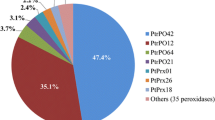Abstract.
Proteins that are preferentially produced in developing xylem may play a substantial role in xylogenesis. To reveal the identity of these proteins, comparative two-dimensional polyacrylamide gel electrophoresis was performed on young differentiating xylem, mature xylem, and bark of poplar (Populus trichocarpa Hook. cv. `Trichobel') harvested at different times of the year. The most-abundant xylem proteins were identified by microsequence analysis. For 17 of these proteins a putative function could be assigned based on similarity with previously characterized proteins, and for 15 out of these corresponding expressed sequence tags (ESTs) were found in the poplar EST database. The identified xylem–preferential proteins, defined by comparing the protein patterns from xylem and bark, were all involved in the phenylpropanoid pathway: two caffeoyl-coenzyme A O-methyltransferases (CCoAOMT), one phenylcoumaran benzylic ether reductase (PCBER), one bispecific caffeic acid/5-hydroxyferulic acid O-methyltransferase (COMT), five S-adenosyl-L-methionine synthetases, and one homologue of glycine hydroxymethyltransferase (GHMT). Remarkably, the biological function of the two most-abundant xylem-preferential proteins (PCBER and a GHMT homologue) remains unclear. In addition, several housekeeping enzymes were identified: two enolases, two glutamine synthetases, one 70-kDa heat-shock cognate, one calreticulin, and one α-tubulin. In comparison to the xylem-preferential proteins, the housekeeping proteins were expressed at significant levels in the bark as well. Also, several additional protein spots were detected for CCoAOMT, PCBER, and COMT by immunoblot. Our data show that for the study of xylogenesis, two-dimensional protein gel comparisons combined with systematic protein sequencing may yield information complementary to that from EST sequencing strategies.
Similar content being viewed by others
Author information
Authors and Affiliations
Additional information
Received: 28 June 1999 / Accepted: 3 September 1999
Rights and permissions
About this article
Cite this article
Mijnsbrugge, K., Meyermans, H., Van Montagu, M. et al. Wood formation in poplar: identification, characterization, and seasonal variation of xylem proteins. Planta 210, 589–598 (2000). https://doi.org/10.1007/s004250050048
Issue Date:
DOI: https://doi.org/10.1007/s004250050048




